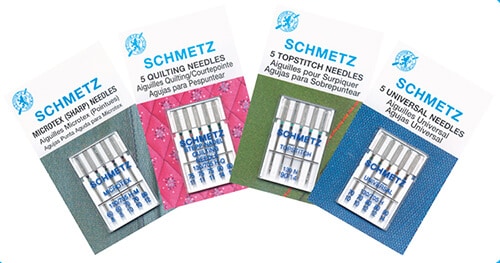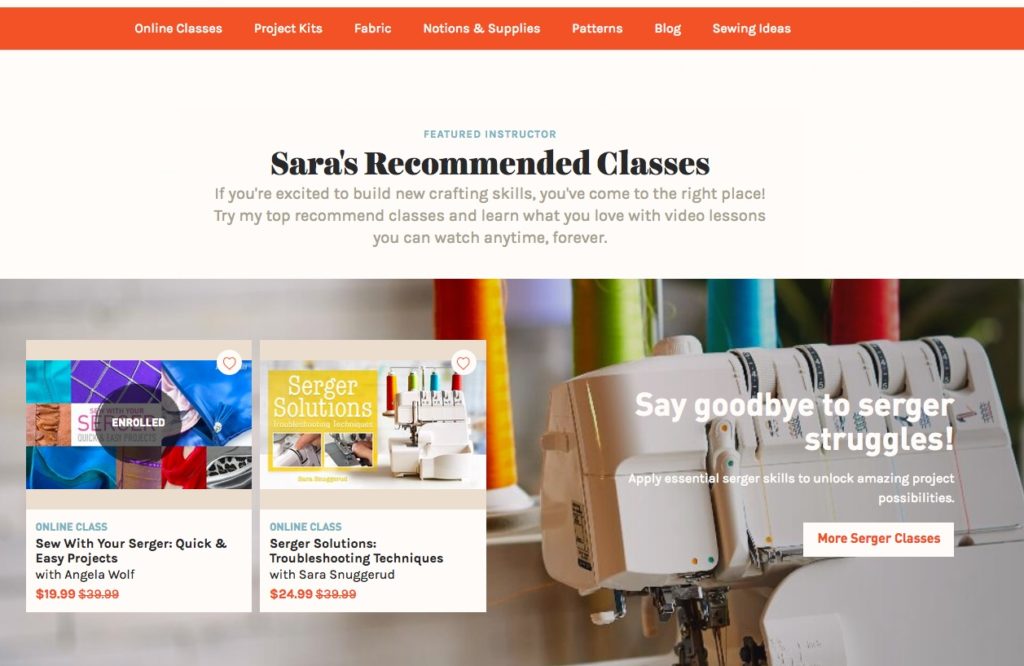
It does not matter what sewing machine you have, or how much money you paid for it, if the sewing machine needle is not good or not the right kind, it will not sew properly. The needle is where “the rubber meets the road”, where the action is, where it all happens. With that said, there is more than meets the “eye” of a sewing machine needle.
Anatomy of a needle:
If there is one thing everyone learns first is that the needle has a flat side on the top of the shaft which goes towards the back of the machine; “flat to the back” is how to remember that. (There are very few very old machines left that have the flat side to the right or left that thread sideways.) If you notice there is a long groove down the front of the needle where the thread hides as the needle goes through the fabric, and a scarf or indentation on the back side around the eye. Both are important for the sewing process to happen. But the point and the eye have everything to do with making the best stitch possible.
Needle numbers:
When buying needles we soon realize there are a bunch of numbers to decipher. One number, 130/705, designates all home sewing machine needles, as opposed to needles for industrial or factory sewing machines that have many different needles and numbers. This is one number that you do not have to memorize.
The important numbers on needles are the sizes, and with that said, there are two different numbering systems, metric and American. When you see something like 80/12 it refers to the diameter of the shaft of the needle, and the “80” is the size in metric and the “12” means the same size in the American numbering system. Numbers can run from 60/8 for the smallest up to 120/ 18, the largest, in increments of tens for the metric system, or twos for the American.
If you remember one number, 80 or 12, and think of average weight cotton fabric that is the right size needle for that type of fabric. If the fabric is heavier then use a larger size needle like 90, and if the fabric is lighter, use a smaller size, 70.
The biggest differences in needles are the shapes of the point and eye, and choosing the correct one for your projects depends on the type of fabric or the thread being used. Knowing the point styles and what each type of needle’s best use is will make the biggest difference in the stitch formation.
Needles should be changed periodically because the friction of the needle going in and out the fabric causes the point to heat up and wear out. Change the needle especially when you start with a new project, or when you have sewed with the same needle through five full bobbins. Of course when the needle breaks, strikes a pin or hits the needle plate, change the needle immediately. If you switch from woven to knit fabrics, change to the appropriate the needle, and use the right needle for unusual threads.
To the unaided eye all needles look alike, but a trip to the sewing store to shop for needles reveals that there are a myriad of different ones. Once the needle comes out of the package there is little in most cases to tell which one is which. Yet the results of sewing with various fabrics and threads and needles will tell a different story. The following is a breakdown of the different kinds of needles, and how to choose the right one for utility sewing and for creative techniques.
Schmetz Needle Education Department – Downloads
The UNIVERSAL point style size 80/12 is the most common needle and is what comes with your machine. It has a slightly rounded point and can work for a variety of fabrics, many woven and knit fabrics. Although a Universal needle will work with most usual fabrics there are needles that are more specialized for extremes of those fabrics.
BALL POINT or JERSEY needles are better for knits in general because the rounded point is gentler for knits and won’t make small holes where the needle pierces the knit.
STRETCH needles are best especially for the very stretchy knits like spandex, bathing suit fabric, and lycras.
JEANS or DENIM needles have the sharpest points and are best for woven fabrics, especially for tightly woven fabrics like denim and canvas. Jeans needles have a larger sizes for thicker thread and come in a size range of 80 – 110.
MICROTEX SHARP needles also have a sharp point and are best for woven fabrics, especially for tightly woven fabrics like silks, polyesters that feel like silk and micro-suede. Microtex Sharp needles are smaller for light to medium weight fabrics and come in a size range of 60 – 90.
QUILTING needles have a sharp point and are designed to stitch the multiple different layers of fabric and batting without skipping stitches.
EMBROIDERY needles are primarily used with rayon threads, and because rayon is not a strong fiber like cotton or polyester it tends to break more often. The eye of the embroidery needle is designed to be gentler on the rayon so that it breaks less.
METALLIC are the best needle to use with metallic threads, and again, the shape of the eye and point makes the difference for best results.
TOP STITCH needles have larger than normal eyes to accommodate thicker or heavy thread such as jeans stitch thread or cordonnet. The needles only come in the largest sizes, 90, 100, and 110.
WING or HEMSTITCH needles are most unusual in that there are flanges on each side of the shaft that help make holes in the fabric for a decorative purpose. The effect, which is a classic technique used with linen or heirloom sewing, is called hemstitching or entredeaux. It needs the right kind of stitch to help hold the holes open. There is also a DOUBLE HEMSTITCHING needle for hemstitching.
TWIN or DOUBLE needles, as the name suggests, are two needles side by side attached to the single shaft like a usual needle. They come in multiple sizes for different weights of fabric, and the spacing between the needles ranges from 1.6mm to 6mm. They sew parallel rows of stitching at the same time, can duplicate the coverstitch look, and with the right foot makes pintucks.
STRETCH TWIN is like the regular twin needle except it comes with stretch needles and only two sizes, 2.5 and 4.0.
TRIPLE NEEDLE is like the twin but has three needles side by side and should only be used with straight stitch.
LEATHER needles have a triangular cutting point for piercing through heavier leather. It may make too large of a hole for light weight leathers such as for clothing, and if so the jeans needle with work with leathers as well.
TITANIUM coated needles will stay sharp longer than regular needle.
DOUBLE EYE needles can use two different threads for shading and texturing effects for embroidery and topstitching. The eyes are positioned above and below each other on the needle shank.
Needles should be changed periodically especially when you start with a new project. When you have sewed with the same needle through five full bobbins it is a good time to change to a new needle. Of course when the needle breaks, strikes a pin or hits the needle plate, change the needle immediately. If you switch from woven to knit fabrics, change to the appropriate needle.
Now that you are a master of sewing machine needles, here are 10 Things You Should Know About Sewing Machine Bobbins.
Want to learn more about sewing and quilting? Join us online at BluPrint for great classes you can take at your leisure including two from Sara Snuggerud.




